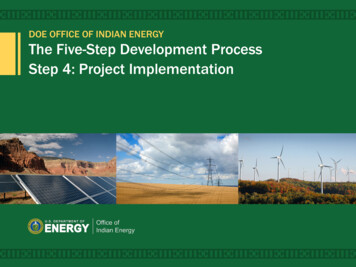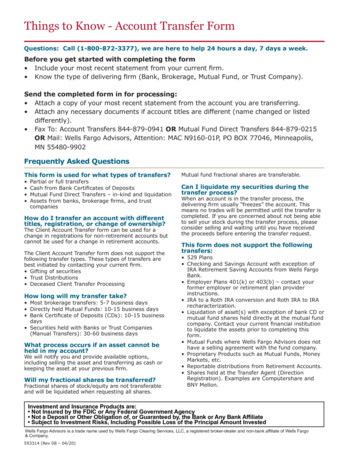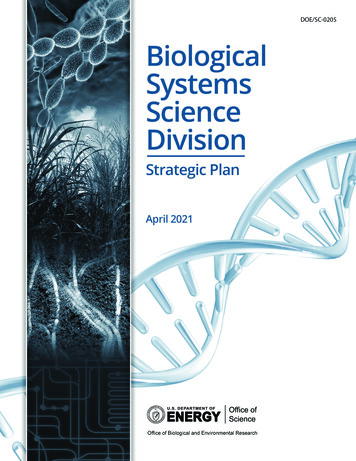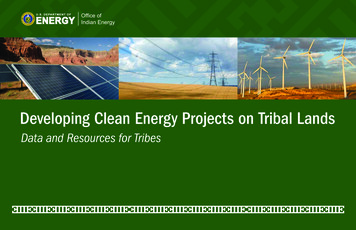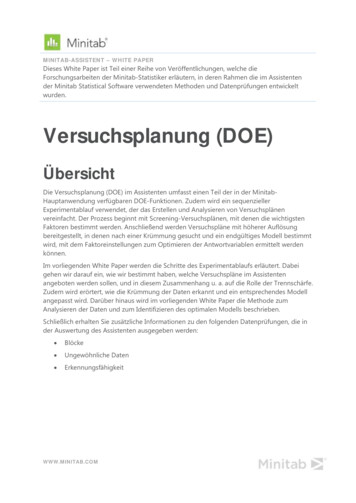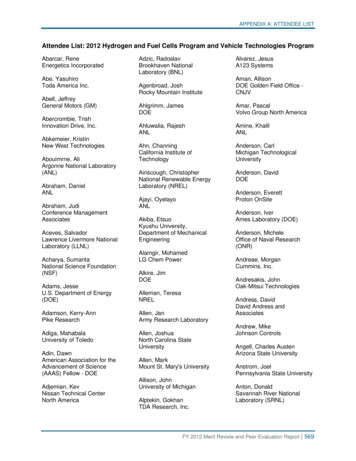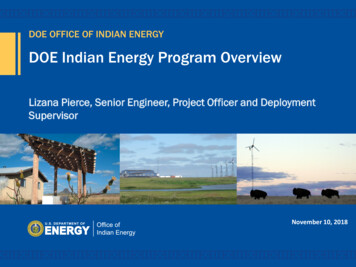
Transcription
DOE OFFICE OF INDIAN ENERGYDOE Indian Energy Program OverviewLizana Pierce, Senior Engineer, Project Officer and DeploymentSupervisorNovember 10, 2018
Statutory AuthorityThe DOE Office of Indian Energy is charged by Congress under the IndianTribal Energy Development and Self Determination Act of 2005 (EnergyPolicy Act of 2005 (EPAct 2005), Title V, codified at 42 USC § 15801) to“provide, direct, foster, coordinate, and implement energy planning,education, management, conservation, and delivery programs that –promote Indian tribal energy development, efficiency, and use;(2) reduce or stabilize energy costs;(3) enhance and strengthen Indian tribal energy and economic infrastructurerelating to natural resource development and electrification; and(4) bring electrical power and service to Indian land and the homes of tribalmembers located on Indian lands or acquired, constructed, or improved(in whole or in part) with Federal funds.”(1)2
Statutory AuthorityIndian Energy Education Planning and Management Assistance(25 USC§ 3502(b))‘‘(1) The Director shall establish programs to assist consenting Indian tribes inmeeting energy education, research and development, planning, and managementneeds.‘‘(2) In carrying out this subsection, the Director may provide grants, on a competitivebasis, to an Indian tribe or tribal energy resource development organization for usein carrying out—‘‘(A) energy, energy efficiency, and energy conservation programs;‘‘(B) studies and other activities supporting tribal acquisitions of energy supplies, services, andfacilities, including the creation of tribal utilities to assist in securing electricity to promoteelectrification of homes and businesses on Indian land;‘‘(C) planning, construction, development, operation, maintenance, and improvement of tribalelectrical generation, transmission, and distribution facilities located on Indian land; and‘‘(D) development, construction, and interconnection of electric power transmission facilities locatedon Indian land with other electric transmission facilities.3
Statutory AuthorityUnder the Department of Energy Loan Guarantee Program (25 USC § 3502(c))Secretary of Energy may provide loan guarantees for an amount equal to not morethan 90 percent of the unpaid principal and interest due on any loan made to an Indiantribe for energy development.Key features: 2 billion in partial loan guarantees Structured for DOE and eligible lender partnership4
5
Vast Underdeveloped Resources 86% of Indian lands with energy ormineral resources remain untapped 15 million acres of potential energyand mineral resources on Indianlands are undeveloped573 Federally RecognizedTribes Only 2.1 million acres of Indian landare being tapped for their energyresources Reservations contain:- 30% of the coal reserves westof the Mississippi- 50% of uranium reserves, and- 20% of known oil and gasreservesTribal Trust Land Comprises57 Million Acres(2012 GAO report)6
Techno-Economic PotentialKey results from this techno-economic potential analysis include: While tribal lands make up approximately 5.8% of the land area in the conterminousUnited States, the estimated utility-scale renewable energy technical potential onthese lands is 6.5% of the total national potential.New Interactive Tool PutsTribal Energy ResourceData in Tribes’ Hands7
Barriers to Energy Development Indian tribes and tribe-owned businessesare non-taxable entities and thus are noteligible to receive federal or state taxincentives, including tax credits,deductions, or other tax subsidies currentlyused to stimulate energy deployment. According to a 2012 study by the Board ofGovernors of the Federal Reserve System,Indian tribes also face a multitude ofchallenges in economic and businessdevelopment in Indian Country. Among thekey challenges are a- Lack of access to capital and- Underdeveloped physicalinfrastructure8
Barriers to Energy DevelopmentMost Significant Barriers (Ranked Order)*Financing / FundingInfrastructureTribal Leadership / StaffCustomerPartnershipsCommunity vision & Stakeholder buy-in &Cultural acceptanceDepends on Regulation, Incentives, EnergyMarketPermittingStrategic Energy PlanningFederal policy & programs* Jones, T., Necefer, L. (2016). Identifying Barriers and Pathways for Success for RenewableEnergy Development on American Indian Lands (SAND2016-311J). Sandia NationalLaboratories (SNL-NM), Albuquerque, NM (United States).9
Program MissionTo maximize thedevelopment anddeployment of strategicenergy solutions that benefittribal communities byproviding American Indiansand Alaska Natives with theknowledge, skills, andresources needed toimplement successfulstrategic energy solutions.Clockwise from top right: Seneca Nation’s (NY) 1.5 MW wind turbine,Fort Yukon’s (AK) combined heat and powerhouse, Coeur d’AleneTribe’s (ID) Benewah Market energy efficiency project, SokaogonChippewa Community (WI) Housing Project, and Chippewa CreeTribe’s (MT) Residential Solar.10
ICEIWGThe Indian Country Energy and Infrastructure Working Group (ICEIWG) workscollaboratively with the DOE Office of Indian Energy to assist in surveys,analysis, and recommendations related to program and policy initiatives thatfulfill DOE’s statutory authorizations and requirements.May 2018 ICEIWG meeting at Sandia National Laboratories11
Performance MeasuresDOE Strategic Objective 5: Increase domestic andinternational accessibility to American energyresourcesOffice of Indian Energy Performance Measures towardsDOE Strategic Objective 5: Between FY 2019 and the end of FY2022, install approximately 25MW ofcumulative new generation capacity ontribal lands Between FY 2019 and the end of FY2022, achieve energy cost savings of 550 million for tribal communities12
Deployment ProgramEducation and Capacity BuildingThorough regional workshops, webinars, and college studentinternships, we support tribal efforts to build internal capacityto develop energy projects and navigate energy markets.Technical AssistanceWe provide federally recognized Indian tribes, includingAlaska Native villages, regional and village corporations, tribalenergy resource development organizations, and other tribalgroups and communities, with technical assistance toadvance tribal energy and infrastructure projects.Access to CapitalWe facilitate access to capital for energy project developmentthrough financial assistance, including competitively awardedgrants, authorized loan program and innovative financingstrategies.13
Access to Capital Financial AssistanceFocused on community and facility hardware deployment Innovative Financing StrategiesPredominately implemented through grants, capacity building,recent roundtables, and research Loan Guarantee ProgramAuthorized in 2005. Funds appropriated FY201714
Financial AssistanceClockwise from top right: Nunamiut people of Anaktuvuk Pass (AK); Assiniboine & Sioux Tribes (MT); Picuris Pueblo (NM); Tonto ApacheTribe (AZ); Chaninik Wind Group (AK); Assiniboine & Sioux Tribes (MT); and in the center, Pueblo of Laguna (NM).15
Invested more than 62.5 million in nearly160 tribal energy projects valued atmore than 130 million (2010-2017)16
Financial Assistance Funding History161422, 14.7036, 13.991232, 10.93 M1014, 7.7086410, 5.6930, 5.6015, 3.87200, 0.00Average of 7.8 million per year17
DOE Investment by Award Type (Millions)More than 62.5 million invested innearly 160 tribal energy projects (2010-2017)Development, 5.81 (9%)Planning, 13.56 (22%)Deployment, 34.18 (55%)Feasibility, 8.92 (14%)18
Financial AssistanceCompetitive Process (2010-2017) 14 Funding Opportunity Announcements issued* Accepted a total of 548 applications (valued at 449 million) Funded 92% of all meritorious applications (Total of 160 out of 174) Funded 30% of all applications received (160 out of 548)DOE average is 5 to 10% Funded 118 different tribal entities (21% of all 573 Indian tribes)All Funds Awarded through a Competitive Process* Includes FOA’s issued in 2009 for 2010 award.19
20
Assisting Tribes Achieve Their Energy VisionInvested 25 million in 43deployment projects valued atmore than 70 million (2010-2017) Installed 18.5 MW of newgeneration on tribal lands Electricity bills reduced for morethan 2,500 tribal government andcommunity buildings and morethan 29,000 tribal members Every 1 in DOE funding willresult in 7.22 savings for thosetribes Average annual savings of 10Mand lifetime savings of a 500million dollars.Tonto Apache Tribe (AZ)Solar photovoltaic systemsinstalled on theirgovernment buildings (267kW under 2014 grant and249 kW under 2015 grant)Forest gestion andbiogas generationfacility (May 2013)Solar arrays on home on theNavajo Nation21
Advancing Tribal Energy Development in AlaskaSolar arrays on home on theNavajo Nation
2016-2017 Tribal SuccessesSeneca Nation of Indians (NY) installation of1.5 MW turbine (April 2017)Picuris Pueblo (NM) completion of the 1 MW solarphotovoltaic system (October 2017)23
2016-2017 Tribal SuccessesSelawik, AlaskaAlaska Native Tribal HealthConsortium (AK) sanitation energyefficiency retrofits for Alakanuk, Kotlikand Noorvik saving over 200,000annually (September 2017)Alaska Native Tribal HealthConsortium (AK) upgradedsanitation facilities in Selawikreducing expenses by 32%, orabout 217,227 annually (2016)24
2016-2017 Tribal SuccessesThe Pala Band of Mission Indians (CA) installed a 91 kW solar system on their Fire Station which will save 52,000 each year or 1.3 million over the life of the system (May 2016)The Gwichyaa Zhee Gwich’in Tribal Government(AK) installed a 18 kW solar system on the TribalOffice to save 11,338 annually (January 2016)25
2016-2017 Tribal SuccessesThe Bishop Paiute Tribe(CA) Residential SolarProgram with two grants fromDOE will install 178 kW on 56homes (April 2017)Soboba Band of Luiseño Indians (CA)1 MW solar installation (July 2016)26
2016-2017 Tribal SuccessesMenominee Tribal Enterprise (WI) Ribbon cutting forbiomass combined heat and power system (April 2016)Southern Ute Indian Tribe (CO) Construction completed on the 1.3MW Oxford Solar Project (June 2017).Rosebud Sioux Tribe (SD) installed a solarsystem on low-income home (August 2016)27
2016-2017 Tribal SuccessesOneida Nation (WI) installed 800 kilowatts ofsolar photovoltaic for 6 buildings (November 2017)Council Of Athabascan Tribal Governments and Gwitchyaa ZheeCorporation (AK) Combined Heat and Powerhouse (below) and theOld Power Plant (top) (December 2017)28
Funding Resources Energy DevelopmentAssistance ToolInformation for Tribes about federalgrant, loan, and technical assistanceprograms available from more than 10federal agencies to support energydevelopment and deployment in IndianCountry and Alaska Native villages Current Funding OpportunitiesList of open tribal energy relatedfunding opportunities from federalagencies and other sources Ongoing OpportunitiesLinks to ongoing technical assistance,grant, loan and loan guaranteeprogramshttp://energy.gov/indianenergy
Technical AssistanceOn-request Technical AssistanceTechnical assistance is to address aspecific challenge or fulfill a need thatis essential to a current project'ssuccessful implementation. Theintended result of this technicalassistance is a tangible product orspecific deliverable designed to helpmove a project forward.Types of Technical Assistance include:– Energy Planning– Housing and Building EnergyEfficiency– Project Development– Resilience– Village Power– Policy and Regulationhttp://energy.gov/indianenergyStrategic Energy PlanningUtilityManagementAssistance30
Technical AssistanceProject Development SupportProject development support consists of expert guidance and analysis thathelps address specific barriers tribes face while developing a clean energyproject.Examples of project development technicalassistance include: Third-party independent reviews oftransmission studies, financing structures,lease agreements, project reports, etc.Objective advice grounded in researchand real-world experience on technologiesModeling and analysis (or assistance inusing available modeling/analysis tools)Pre-feasibility transmission studiesInterconnection agreement facilitationEconomic evaluationsSystem design reviewsOther specific studies or analysis,upon request31
Technical AssistancePre-feasibility Transmission Studies Northern Cheyenne Tribe (November 2017) Jicarilla (May 2017) Mesa Grande (October 2017) Hopi (April 2016) Torres Martinez (October 2015) Walker river (September 2015) Saginaw Chippewa (November 2014) Mesa Grande Band (October 2014) Turtle Mountain Band (September 2014) Oglala Sioux (June 2014) Nez Perce Tribe (December 2013) Ione Band (November 2013) San Carlos Apache (May 2013) Chemehuevi Tribe (May 2013) Ute Mountain Ute Tribe (Feb 2011) Hualapai Tribe (July 2010) Navajo Hopi Land Commission (May 2010) To’hajiilee (March 2010)32
Technical Assistance Feedback“This was very helpful! Now we have tofigure out what we want to do. The studywas very detailed. We appreciate the workby WAPA.”“This was so good for us! We aresaving more money now so we canbuy more gas to go hunting andfishing.”“Electricity is very expensive here. Ourgoal is affordability and the PCEassistance helped us move toward thatgoal.”“The WAPA market analysis was veryuseful.”“The workshop was very good. We knewwe had energy resources but not howmany! This also helped us understandhow to better plan for our future energyneeds.”“This was perfect assistance. NREL andAEA helped us find the problems andcorrect them. Thank you for your help.”33
Resources Information Resources– Energy Resource LibraryProvides links to helpful resourcesfor tribes on energy projectdevelopment and financing on triballands. The library includes links totopically relevant publications,websites, videos, and more.– Curriculum Foundational andAdvanced CoursesEducational webinars on strategicenergy planning, projectdevelopment, resourcestechnologies, and advance conceptssuch as business structures andfinancing Workshops & Webinars– Monthly WebinarsMonthly webinars providefoundational information, resourcesand case studies– Periodic WorkshopsWorkshop on specific topicshttp://energy.gov/indianenergy34
Monthly WebinarsCo-sponsored by the Office of Indian Energy andWestern Area Power AdministrationTotal of 2,140 registered and 1,215 attended theten webinars conducted in FY 201635
Tribal Energy AtlasNew Interactive Tool Puts Tribal Energy Resource Datain Tribes’ HandsTo access, see the Indian Energy website at www.energy.gov/indianenergy36
Tribal Energy AtlasFirst-of-its-kind interactive geospatial application thatenables tribes to conduct their own analyses of installedenergy projects and resource potential on tribal lands.To access, see the Indian Energy website at www.energy.gov/indianenergy37
Tribal Energy AtlasIncludes the most current technical and economic tribalenergy potential estimatesIncludes: Energy resourcedata Infrastructureinformation Environmentalinformation Energy efficiency Electricity andnatural gas pricesTo access, see the Indian Energy website at www.energy.gov/indianenergy38
Student Summer InternshipsProgram Highlights (2010-2017) 20 undergraduate and graduate interns 11 different tribal affiliations represented 10 different student majors 20% converted to year-round statusInterns at Grand Canyon West (2010) 15% of interns hired as full-timeemployees or Sandia contractorsAnnouncement for Summer2019 Internships Expected inJanuaryInterns with Sandra Begay (2014)39
Assisting Tribes Achieve Their Energy VisionPV System (6 kW) at SIPI’s (NM) Science and TechnologyBuildingSolar arrays on Navajo home (AZ)Jicarilla Apache Reservation PV array onDulce High School (NM)Rosebud Sioux’s (SD) LittleSoldier TurbineFirst 750 kW Turbine on TribalLands in the Contiguous U.S.Solar Installations at Pueblo of Laguna’s MajorsRanch (NM)40
Questions?Lizana Pierce, Deployment SupervisorU. S. Department of EnergyOffice of Indian EnergyTelephone: (240) 562-1749Email: lizana.pierce@hq.doe.govProgram HelpdeskTelephone: (240) 562-1352Email: indianenergy@hq.doe.govSubscribe to “Get Our Email Updates”http://energy.gov/indianenergy41
2 billion in partial loan guarantees Structured for DOE and eligible lender partnership 4 Secretary of Energy may provide loan guarantees for an amount equal to not more than 90 percent of the unpaid principal and interest due on any loan made to an Indian tribe for energy development. Under the Department of Energy Loan Guarantee Program
